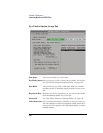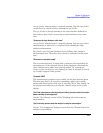
133
Chapter 3: Reference
Importing Netlist and ASCII Files
If a channel appears in multiple labels, selecting that
channel will select it in each of those labels.
See Also “Understanding State Mode Sampling Positions” on page 208
“To automatically adjust sampling positions” on page 47
Eye Finder Advanced Settings Dialog.
Short Eye finder looks at 100,000 clock cycles on each channel
to determine the suggested sampling positions. This setting
requires frequent transitions on all channels.
Medium Eye finder looks at 500,000 clock cycles on each channel
to determine the suggested sampling positions. Use this for
channels that transition at a normal rate.
Long Eye finder looks at 2.5 million clock cycles on each
channel to determine the suggested sampling positions.
Use this setting if some channels have sporadic transitions.
Some things to consider when selecting among the eye finder
advanced settings are:
• Upper address bits that don't transition as frequently as lower address bits.
• Data buses that are driven by different circuitry at different times.
When different channels require different settings, you can run eye
finder on channel subsets to avoid using the Long setting on a large
number of channels.


















